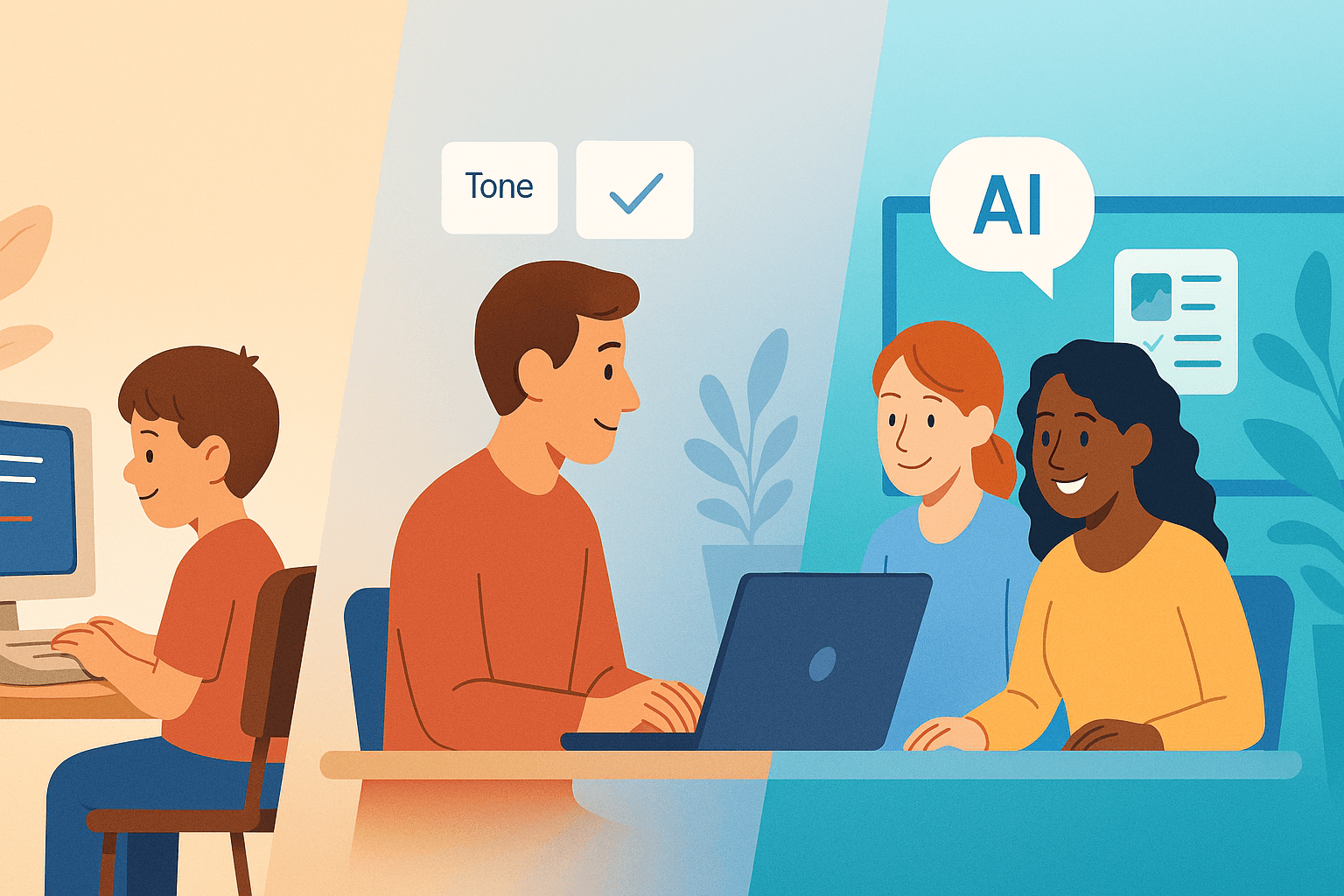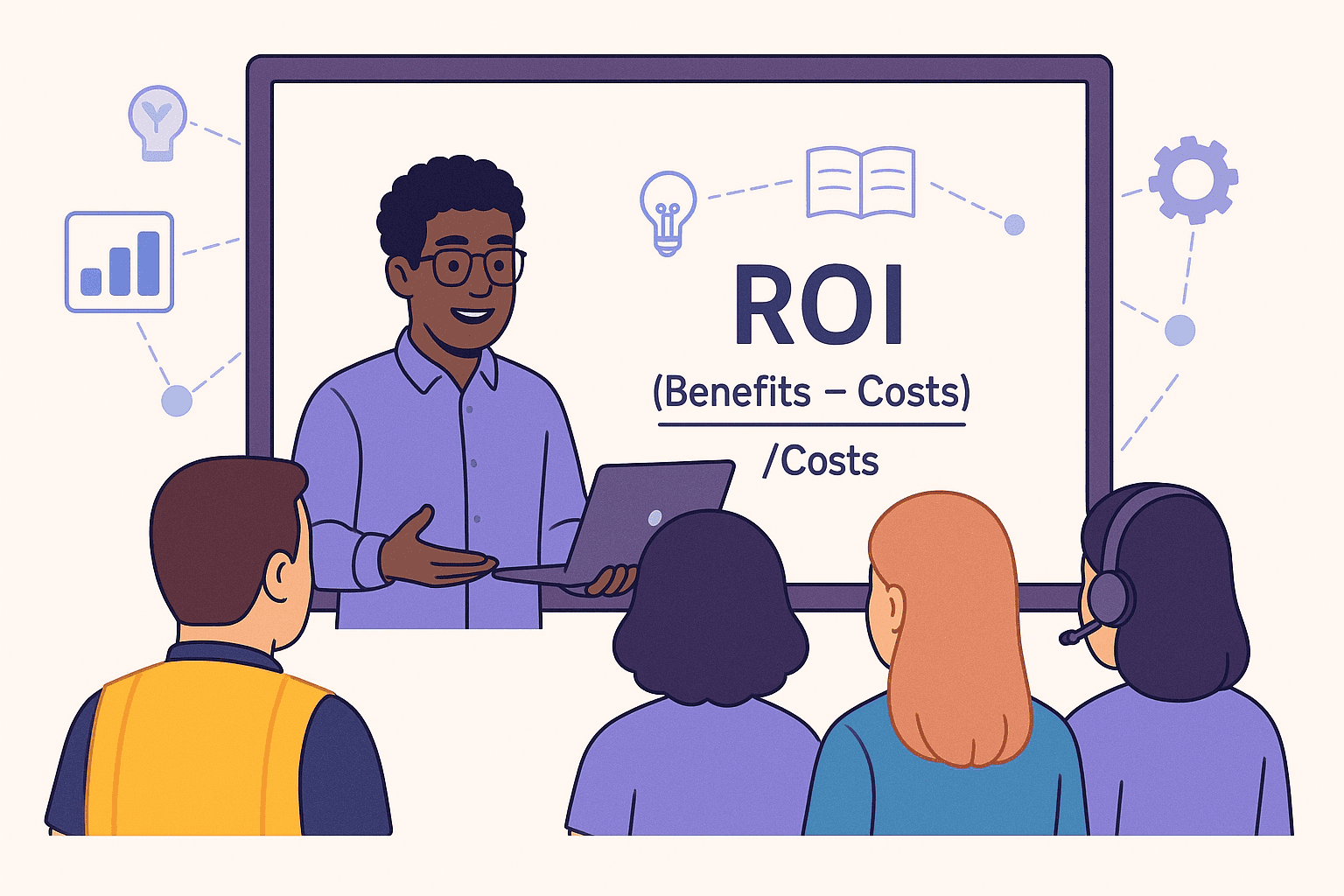7 min
Apr 5, 2024
What my experience learning English taught me about accessibility in eLearning
Lara Cobing

In our rapidly evolving workplace, the diversity of our workforce is a strength that drives innovation, creativity, and resilience. This brings me back to when I was a part-time worker going through college in Hawaii. I grew up in the Philippines, so English isn’t my first language. Sometimes I struggle to explain a thought, or I have to explain the cultural context to explain why a joke was funny. Aside from that, I worked in a tourist center wherein we received guests from all around the world! Some guests barely speak English so the center has language tour guides. Some guests decide not to use this service, and I’d run into these groups. Though at times we communicate through body language, translation phone apps are the most helpful.
Yet, despite this diversity, one area often overlooked is the accessibility of eLearning experiences. As eLearning becomes a staple for training and development in organizations, we must design these experiences to be inclusive for everyone, regardless of their abilities. This concept, known as "Design for All," is not just about compliance or ticking boxes—it's about creating learning experiences that empower every individual to achieve their full potential.
Understanding Accessibility in eLearning
What is Accessibility?
Accessibility in eLearning is a multifaceted concept aimed at removing barriers that might prevent individuals with disabilities from engaging fully with online educational materials. It encompasses the design, development, and delivery of eLearning courses in such a way that all learners, regardless of their physical or cognitive abilities, can access, understand, and benefit from the content. This commitment to inclusivity not only enhances learning opportunities for individuals with disabilities but also improves the overall learning experience for all students by fostering a more versatile and adaptable educational environment.
Key Considerations for Accessibility in eLearning
Visual Accessibility: Designing content that is accessible for learners with visual impairments involves more than just offering alternative text for images. It includes ensuring high contrast between text and background, allowing font size adjustments, and ensuring compatibility with screen readers. Layouts should be organized and predictable, with consideration for color-blind users by not relying solely on color to convey information.
Auditory Accessibility: eLearning courses should provide transcripts and closed captioning for audio and video content for individuals with hearing impairments. Sign language interpretation is also important for deaf learners, as it ensures that all auditory information is conveyed visually or textually.
Motor Accessibility: Accessibility for learners with motor impairments involves designing interfaces that can be navigated using keyboard shortcuts, voice commands, or assistive devices like eye-tracking technology. It's crucial to minimize the need for precise movements, such as through extended clickable areas, and to allow for customizable input methods.
Cognitive Accessibility: eLearning content should be designed to support learners with cognitive challenges, which means avoiding overly complex navigation structures, providing clear and consistent instructions, using plain language, and allowing learners to control the pace of content delivery. Supporting tools like glossaries, practice quizzes, and the ability to review material can also enhance cognitive accessibility.
Overlooked Aspects of Accessibility
While these considerations are critical, there are often overlooked aspects of accessibility in eLearning that can significantly impact the effectiveness of educational materials for learners with disabilities:
Emotional Accessibility: Emotional and psychological barriers can affect learning. Creating an inclusive learning environment that supports mental health, minimizes stress and anxiety, and promotes a sense of belonging can make educational content more accessible to all learners, including those with mental health challenges.
Technological Accessibility: Ensuring that eLearning platforms are compatible with a wide range of devices, operating systems, and assistive technologies is crucial. Overlooking this can alienate learners who may rely on specific technologies to access eLearning content.
Socioeconomic Accessibility: Accessibility is not only a matter of design but also availability. Learners from low-income backgrounds may lack access to the necessary technology or internet connectivity to participate in eLearning. Addressing these disparities requires considering offline access, mobile-friendly design, and low-bandwidth options.
Cultural and Linguistic Accessibility: Content that is culturally inclusive and available in multiple languages can enhance accessibility. This involves considering diverse cultural contexts, providing language options, and avoiding cultural biases in examples, imagery, and language.
Incorporating these overlooked aspects into the design and delivery of eLearning courses can significantly enhance the accessibility and inclusivity of educational content. It requires a holistic approach that considers the vast array of human diversity and the different ways individuals interact with digital content. By prioritizing accessibility, educators and designers can ensure that eLearning is truly for everyone, breaking down barriers to education and enabling all learners to achieve their potential.
The Legal Landscape
In the United States, the Americans with Disabilities Act (ADA) sets forth guidelines that apply to digital content, including eLearning. Failure to comply can not only lead to legal repercussions but also alienate a significant portion of your workforce. As I mentioned, I worked at a tourist center in the past, and I’ve observed how they ensured they complied with the ADA. Some examples of what they do is that there were wheelchairs available to rent, ramps, and wheelchair-accessible areas in the whole center. For those who are deaf or hard of hearing, there are American Sign Language Interpreters upon request. Service animals are also welcome! Simply put, compliance isn't just a legal requirement—it's a moral and ethical obligation to inclusivity.
Benefits of Accessible eLearning for Businesses
Accessible eLearning doesn't just benefit learners with disabilities; it enhances the learning experience for all employees. Here are a few key advantages:
Enhanced Learning Outcomes: By accommodating various learning styles and needs, businesses can see improved performance and mastery of skills across their entire workforce.
Increased Engagement: Accessible eLearning materials can lead to higher levels of employee engagement and satisfaction, as all employees feel valued and supported.
Competitive Advantage: Inclusivity can be a significant differentiator in attracting and retaining top talent, making your business more attractive to diverse candidates.
Risk Mitigation: Compliance with legal standards minimizes the risk of costly lawsuits and fines.
Principles of Accessible eLearning Design
Universal Design for Learning (UDL)
UDL is a framework that guides the design of instructional materials and activities that are accessible and challenging for all learners. It emphasizes providing multiple means of engagement, representation, action, and expression to accommodate diverse learning preferences and abilities.
Key Elements of Accessible Content
Accessible eLearning content is crafted to accommodate the varied needs of all learners, ensuring no one is left behind. This design philosophy involves the following:
Text: Use readable fonts and provide alternatives for text, such as audio descriptions, to enable individuals with visual impairments to understand visual content through descriptive language.
Audio and Video: Include captions and transcripts for audio and video content to cater to those with hearing difficulties by translating auditory information into readable text.
Interactivity: Ensure interactive elements are keyboard-accessible and compatible with assistive technologies to ensure users with mobility or dexterity challenges can engage with the content effectively.
Strategies for Implementing Accessible eLearning
Conducting a Needs Assessment and Choosing the Right Tools
Understanding your learners' specific needs and preferences is the first step in creating accessible eLearning content. This might involve surveys, interviews, or consultations with accessibility experts. Not all eLearning platforms and tools are created equal when it comes to accessibility. Many modern learning management systems (LMS) come with built-in accessibility features, but it's important to test these features to ensure they meet your learners' needs. Selecting technologies that adhere to accessibility standards (such as WCAG) is crucial.
Finding a WCAG AA Compliant eLearning Tool
As eLearning platforms and tools become increasingly integral to educational systems worldwide, ensuring these technologies are accessible to all learners, including those with disabilities, is crucial. This is where the Web Content Accessibility Guidelines (WCAG) come into play, setting the standard for web accessibility. For educators, institutions, and organizations looking to choose an eLearning tool, ensuring compliance with these guidelines, specifically the WCAG AA level, is a significant consideration.
The Web Content Accessibility Guidelines (WCAG) provide a framework for enhancing digital content accessibility for individuals with disabilities, including those with visual, auditory, motor, and cognitive challenges. Organizations typically aim for WCAG AA compliance, a level that offers a balance between comprehensive accessibility standards and the feasibility of implementation. Achieving WCAG AA compliance signifies that a digital tool or platform has met stringent criteria to ensure its content is universally accessible, incorporating features like text alternatives, keyboard functionality, adequate time for content consumption, and seizure-safe design elements.
Mindsmith distinguishes itself in the eLearning landscape through its innovative educational approaches and a strong emphasis on accessibility. It proudly meets the WCAG AA compliance standards, underscoring its mission to foster an inclusive learning environment accessible to learners of all abilities. This achievement is not merely symbolic but reflects Mindsmith's deep commitment to delivering educational content that is universally accessible. The platform has been rigorously tested and refined to incorporate a comprehensive array of accessibility features, such as text alternatives for visual and auditory content, keyboard-navigable interfaces, and adjustable timing for content interaction. Mindsmith's dedication to accessibility is ongoing, with continuous efforts to improve and adapt to the changing needs of a diverse learner demographic through regular updates and responsive feedback mechanisms.
Creating Accessible Content
When developing eLearning materials, incorporating simple yet effective practices can significantly enhance content accessibility. An essential practice is the use of alt text for images, which provides a textual description of visual content, allowing learners with visual impairments to understand the context and content of images through screen readers. Additionally, ensuring that information is not conveyed through color alone is crucial for those with color vision deficiencies. This practice helps in making educational content inclusive for individuals with diverse needs.
Mindsmith takes these accessibility practices a step further by automatically generating alt text for AI-generated and web-uploaded images, a pioneering feature that underscores its commitment to inclusivity. This innovative approach not only streamlines the creation of accessible content but also ensures that all learners, regardless of their visual abilities, can fully engage with and benefit from the rich, visual educational materials. By integrating these features into its platform, Mindsmith demonstrates an exemplary model of how eLearning tools can embrace and advance accessibility, making learning experiences more equitable and comprehensive for everyone.
Evaluating and Enhancing eLearning Accessibility
Evaluation is a critical step in ensuring the accessibility of your eLearning programs. Use accessibility-checking tools to test your materials, and remember to gather feedback directly from learners with diverse abilities. Accessibility should be seen as an ongoing commitment, not a one-time effort. As technologies and standards evolve, so too should your eLearning materials.
Case Studies and Success Stories
One notable example of success in eLearning accessibility comes from Microsoft, a leading global technology company renowned for its commitment to creating inclusive environments. Microsoft embarked on an initiative to enhance the accessibility of its training programs, grounded in a comprehensive needs assessment aimed at identifying and addressing potential barriers faced by employees with disabilities. By leveraging its suite of accessibility tools available through Microsoft 365, including features designed to support users with visual, hearing, mobility, and cognitive challenges, the company set a new standard for accessible eLearning.
Microsoft's approach involved close collaboration with accessibility experts and integration of a Learning Management System (LMS) that emphasized accessibility from the ground up. This strategic move enabled the redesign of training materials to be fully accessible, ensuring compliance with the Americans with Disabilities Act (ADA) standards and beyond. The impact was profound, leading to a more inclusive learning environment that not only benefited employees with disabilities but also fostered greater engagement and satisfaction across the entire workforce.
Through its efforts, incorporating accessibility into eLearning can create a more equitable and productive workplace. This case study is a powerful example for other organizations striving to make their eLearning programs accessible to all learners, showcasing the tangible benefits of prioritizing inclusivity in corporate training initiatives.
Conclusion
The journey toward creating accessible eLearning experiences is ongoing, requiring commitment, creativity, and collaboration. By embracing the principles of "Design for All," HR professionals can play a pivotal role in fostering an inclusive culture that values and supports diversity in all its forms. Remember, when we design with everyone in mind, we unlock the potential for all learners to grow, contribute, and thrive within our organizations. Let's commit to designing eLearning experiences that are for all.



